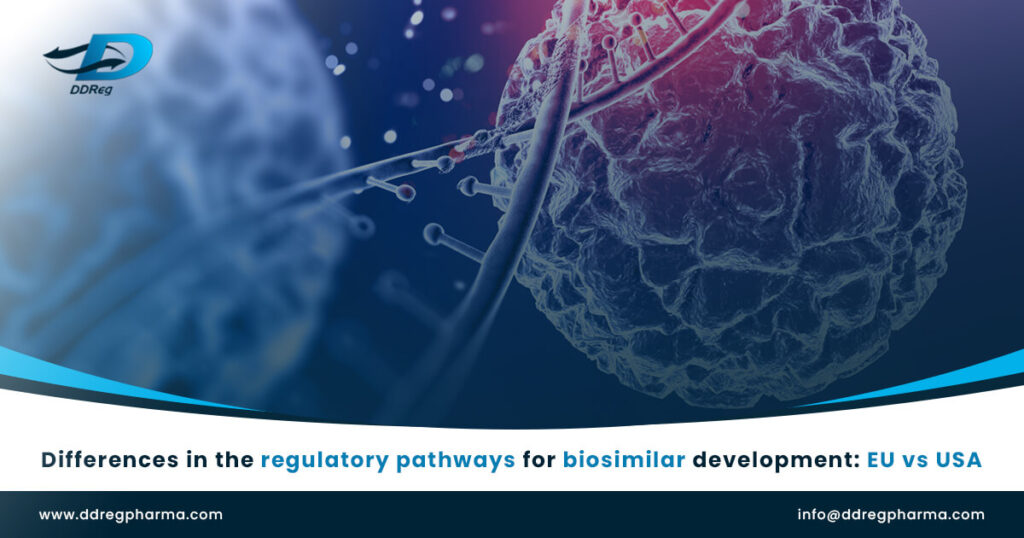Regulations surrounding biosimilar development are based on how well the similarity between the proposed molecule and the reference product (RP) can be demonstrated. Indeed, there is a need for increased access to cost-effective treatment for various conditions, which drives biosimilar regulatory pathway development. Regulatory agencies such as the US Food and Drug Administration (FDA) and the European Medicines Agency (EMA) have similar requirements for demonstrating biosimilarity, i.e., head-to-head comparisons across pre-clinical, clinical, pharmacokinetic (PK)/pharmacodynamic (PD) physiochemical characterization, biological activity, etc. However, EMA’s biosimilar guidelines are based on the classification of the biological molecule, where policies are available for different product classes. In contrast, the US FDA takes a more case-by-case approach.
Comparison of biosimilar regulatory pathway rates
EMA’s biosimilar guidelines were established in 2005, and they approved their first biosimilar in 2006 [2]. Meanwhile, the US FDA approved their first biosimilar in 2015 and demonstrated a faster approval rate for biosimilars during the first four years of implementing their guidelines (16 biosimilars) compared to the first four years of EMA implementing their policies (13 biosimilars) [3]. The difference in approval rate and time for biosimilars can be attributed to differences within the respective biosimilar regulatory pathway. Biosimilar commercialization cannot only widen the range of therapeutic options available at relatively lower prices but also instigate competition where prices for originator products are reduced, thereby driving the biosimilar market from the perspective of economic opportunity and consumer affordability.
Understanding Post-Approval Manufacturing Changes in Biosimilars and Interchangeable Products in USA
Exclusivity period, assessment fees, and interchangeability
The exclusivity period for biologics is 12 years in the USA and ten years in the EU; with several biologic patents and exclusivities expiring across the globe and more that are due for expiration in the year 2023, the space for biosimilar growth in the market is wide open. However, due to the stringent requirements for biosimilars in terms of development, manufacturing, and licensing, the save on cost is not as ‘fruitful’ compared to generics; 15-30% of the price is held for biosimilars vs. 80% cost that is reserved for generics . Nevertheless, the burden on healthcare costs would still be reduced and would encourage biosimilar development.
A study revealed that switching to a rituximab biosimilar would save roughly EUR 56 billion in Europe. Another study demonstrated significant cost savings when switching to an erythropoietin biosimilar in patients with chemotherapy-induced anemia. This allowed additional treatments with trastuzumab, rituximab, and bevacizumab.
The difference in cost for biosimilar development, application, and even for seeking scientific advice could make specific markets more favorable than others. For example, the US FDA has established fees for assessing biosimilar biological products for fiscal years 2023 to 2027. On the 30th September 2022, the FDA User Fee Reauthorization Act 2022 for biosimilars- also known as the BsUFA III- was enforced to expedite critical processes involved in biosimilar development, including biosimilar biological product application review & post-market safety surveillance activities. The BsUFA III aims to ensure safe and effective biosimilar therapeutic options are developed for patients. Per the explanatory note on general fees payable to EMA, the primary and additional fees are listed for applications, extensions, variations, renewals, inspections, and more, including the costs for scientific advice requests (initial and follow-up).
Furthermore, with the EMAs announcement of biosimilars being interchangeable earlier this year, the cost that sponsors face for biosimilar development would be relatively less, and the processes would be more simplified. However, the FDA and federal law requires manufacturers to provide additional supporting evidence to demonstrate interchangeability between biologic products, such as clinical switching studies, which could hinder bringing more biosimilars that can be interchanged to the market.
Critical differences in biosimilar regulatory pathway of the USA and the EU contribute towards biosimilar penetration in the respective regions. Inevitably, there is a need for biosimilars to treat chronic conditions at more affordable prices. Biologics patents have been expiring and continue to do so, leaving ample opportunity for the biosimilar market to grow. However, it is essential to have access to a more systematic approach to biosimilar development and rapid market access.
Conclusion
In addition to providing regulatory affairs and pharmacovigilance services, DDReg offers comprehensive support in biosimilar development by creating and validating regulatory strategies per stringent regulatory authority guidelines like the US FDA and EMA. Our team conducts a meticulous gap analysis to ensure compile dossiers that include the necessary data on manufacturing, pre-clinical & clinical testing per the regulatory requirements.
European Medicines Agency. Biosimilar medicines: Overview. 2022
US Food and Drug Administration. Biosimilar User Fee Amendments. 2022

